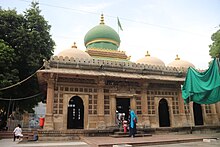Wajihuddin Alvi
Wajihuddin Alvi | |
|---|---|
| Personal | |
| Born | 1490s |
| Died | 1580 (aged 89–90) |
| Resting place | Wajihuddin's Tomb |
| Senior posting | |
| Teacher | Muhammad Ghawth |
| Successor | Hashim Pir Dastagir |
Students
| |
| Part of a series on Islam Sufism |
|---|
 |
| |
Shah Wajihuddin Alvi Gujarati (Persian: شاه وجیه الدین علوی گجراتی), also known the epithet Haider Ali Saani (Persian: حیدر علی ثانی), was an Islamic scholar and Sufi in the Shattari tradition.
Life[edit]
Shah Wajihudeen Alvi Hussaini Shattari (Haider Ali Saani) 'Ali the second' was born in Champaner, Gujarat in the last decade of the 15th century. He later moved to Ahmedabad where he received an education in Islamic studies. He taught Quranic studies, Islamic law, mathematics and logic for sixty-five years. He was initially a follower of the Qadiri Sufi tradition, but upon meeting Mohammed Ghaus Gwaliori he joined the Shattari Sufi tradition. Under his leadership, Ahmedabad became a major centre of Islamic studies, attracting students from all over India. Many of his disciples became prominent figures, including Syed Sibghatallah al-Barwaji, who moved to Medina and established the Shattari tradition in Saudi Arabia, Sheikh Abdul Qadir, who settled in Ujjain, and Sheikh Abu Turab, who moved to Lahore. He also had students from Bengal such as Usman and Yusuf, who contributed to Islamic education in medieval Hindustan.[1][2] Wajihuddin wrote more than 200 books on various subjects.[citation needed]
According to some sources, Sayyadna Hashim Peer Dastagir was his nephew and Khalifa. [3]
Works[edit]
Wajihuddin Alvi is reported to have written books in Arabic and Persian[4]
- Hashiya Alvi Ala Tafsir Baydawi حاشية العلوي على تفسير البيضاوي
- Sharh Nuzhat Al-Nazar شرح نزهة النظر للكجراتي مع نخبة الفكر للعسقلاني
- Hashiya Alvi ala Sharh al-Jami https://archive.org/details/hashiya-alvi-ala-sharh-al-jami
- Aidah Haqiqat Sharh Haqiqat Muhamadi ايضاح حقيقت شرح حقيقت محمدي
Death and burial[edit]

He died in 1580 CE.[5] He is buried in a memorial tomb in Khanpur, Ahmedabad, that was built by his disciple Syed Murtuza Khan Bukhari, the eleventh (1606–1609) governor of Ahmedabad during the reign of Jahangir.[6][7][8]
References[edit]
- ^ al-Kumillai, Muhammad Hifzur Rahman (2018). "الشيخ الفاضل عثمان بن أبي عثمان البنغالي" [The honourable Shaykh ʿUthmān bin Abī ʿUthmān al-Bangālī]. كتاب البدور المضية في تراجم الحنفية (in Arabic). Cairo, Egypt: Dar al-Salih.
- ^ (۶۰۸) یاد شیخ یوسف بنگالی رحمہ اللہ. Gulzar-e-Abrar (in Urdu). pp. 358–359.
- ^ "Shattari silsila". Retrieved 2 June 2021.
- ^ Khayr al-Din al-Zirikli; Zirikli (2002). Al-Alam. Islam Kotob. p. 110.
- ^ Nūrulḥasan Hāshimī; Valī (1986). Wali. Sahitya Akademi. p. 13.
- ^ Trimingham, John Spencer and Voll, John O. (1998). The Sufi orders in Islam. Oxford University Press USA. pp. 97–98. ISBN 0-19-512058-2.
{{cite book}}: CS1 maint: multiple names: authors list (link) - ^ Achyut Yagnik (2 February 2011). Ahmedabad: From Royal city to Megacity. Penguin Books Limited. p. 42. ISBN 978-81-8475-473-5.
- ^ Gazetteer of the Bombay Presidency: Ahmedabad. Government Central Press. 1879. p. 278.
dastur khan mosque.


 French
French Deutsch
Deutsch